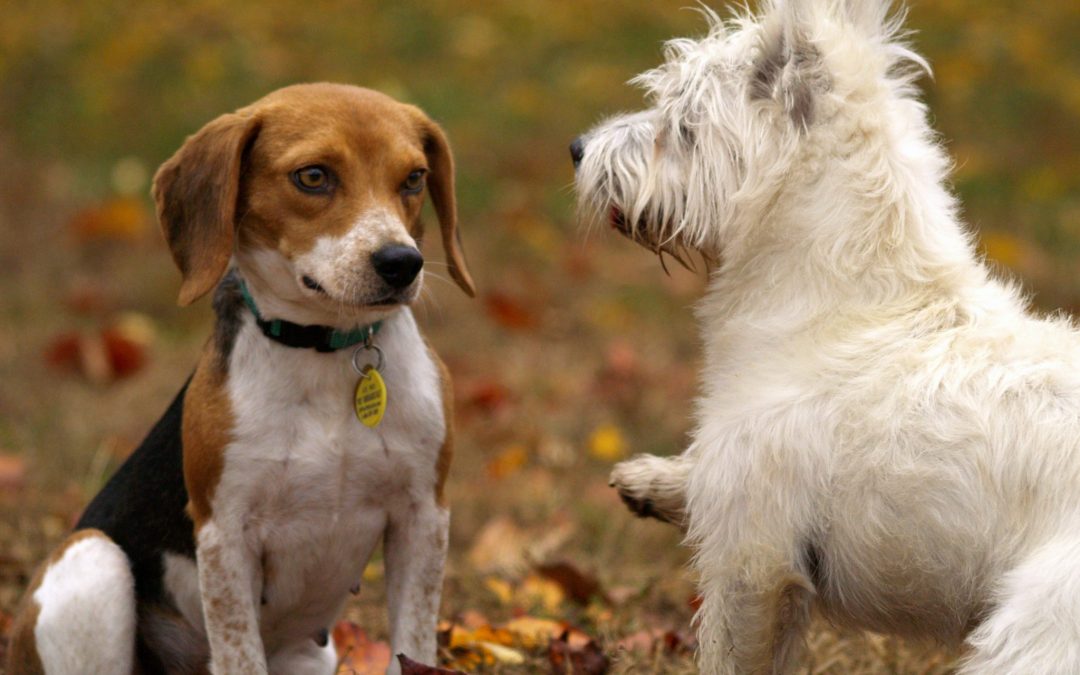How important is socializing your dog? Socializing is extremely important, for any dog, and it is best done when the dog is a puppy of between eight and sixteen weeks old. There is a slight problem with this time frame, however, since puppy’s need to be vaccinated to ensure that they do not get life threatening diseases like Parvo and vaccines are only really effective after the age of twelve weeks. You see, when the pups are born they are fed their mama’s milk, which is chalk full of colostrum and colostrum is full of antibodies that help protect the pups from foreign things, like viruses. When a puppy is vaccinated, before the age of twelve weeks, the mothers colostrum will actually kill off the vaccine. I will do a whole separate blog on that another day, but, pertaining to socialization, this can create a problem because puppies really shouldn’t be introduced to areas where there might be puppy germs, yet they need to be socialized. See the conundrum here?
As I have mentioned before, we live on a ranch. Over the years, we have had ranch dogs that simply stay here, on the ranch. I never really thought much about socializing them until, one day, I had to take one of our hundred plus pound dogs into the vet. Now, she had never been on a leash and had never even been off of our property. Getting her into the vehicle was not a huge problem, as she was used to seeing the other dogs go in and out. However, when it came time to take her into the vets office, she simply refused. I mean, layed-down-and-wouldn’t-move refused. Obviously, I could not pick her up and carry her in. Thankfully, the vet offered to come out to the car for the appointment. This moment taught me just how important socializing is. Even if you don’t want to be one of “those people” who take your dogs into places, the basics in getting them comfortable with being out and about are very very important, and could be life saving. Our house burring down was a perfect example of this rule; had our dogs not been used to people and noises and cars, they would have never come out of the house and would have certainly never have gotten into the cars that took them away from the danger.
This is what I do: I take my puppies with me when I run errands in town. (Use common sense in regards to the heat index, please) I know that my car is a safe place, free from any illnesses, so they are safe safe safe in there. Even if they are in a parked car, they still get to experience people walking by, cars driving by, trucks making loud noises, trains rumbling through town, and so forth. While they may not have direct contact with other people, they are still getting exposed to things, outside of their normal living environments. I also take them to places that allow dogs, like Lowe’s and Petco/Petsmart. These are great places because they get to see other dogs, cats, birds, and other “out of the norm” things. However, I carry them and never put them down on the floors where the highest amount of puppy illnesses would be present. The best time of day to visit these places, because presumably, it is when the store is the cleanest, is first thing in the morning. Just walk around and let people talk to them, pet them, make googley faces and kissy sounds at them. It will teach your pup that people are generally “okay”.
Now, what do you do if your puppy is a little timid or scared? One of the best rules to remember about dogs, in general, is that they need a pack leader. A strong, confident, and secure pack leader. Do not coddle them if they shy away from something that they perceive as “unsafe”. Ignore the behavior. Do not tell then that it is okay, just stay strong and brave, within yourself, and they will follow along. Rewarding bad or scared behavior is teaching them to behave that way, so don’t. Rewarding the desired behavior is what you want to do. When they sit nicely and let a stranger pet them, after the stranger has asked first, you absolutely reward that, either with treats or verbally. This is a good rule of thumb to remember when trying to train bad behaviors out of your fur-friends as well. I have a friend who complains that her dog, who weighs about sixty pounds, jumps on everyone and always has. I asked her when this started. She told me that when her dog was a puppy, she thought it was really cute for the, then puppy, to put its front paws on your shoulders for a “hug”. She would even kneel down so that the puppy could reach the owners shoulders so that it truly resembled a “hug”. Really? Is this not blazingly obvious? This puppy was rewarded with kisses and hugs and petting every time it jumped up on someone, so why in the world would the, now grown dog, not think that is acceptable behavior? My dogs are trained, from day one, that if they jump on me, or anyone else, they will not be pet. It is only in the sitting position that they will be rewarded with a pat on the back and a “good dog”. My puppy, Henry, is so good at this that he actually gets his feelings hurt when someone new doesn’t understand the “good dog cue” and they don’t pet him when he is sitting so nice and pretty. For this, like so many other things, consistency is key. Never reward a bad behavior.
Okay, back on track to socialization. While you shouldn’t reward timidness or cowering, you should also make sure that your puppy is safe. It is your job, as a dog owner, just like it is as a parent, to ensure that safety is always provided. Don’t let strangers run up to your dog and pet them without asking your permission, first. This rule should especially apply to children. Children have little control over their emotions, and that includes the emotion of excitement…especially excitement. I mean, even as an adult, when I see a really cute puppy the inner child in me wants to squeal and run toward it, plucking it out of its owners arms and smother it with kisses. Now, since I am an adult, most of the time, I control that urge and am usually able to calmly and quietly ask the owner if I can please pet their dog. Children, on the other hand, do not have this ability so they can, out of excitement, cause some trust issues that you will then need to undo. I am always pretty observant with what is happening around me and I tend to keep a pretty close eye on the youngsters. A simple explanation or just asking them, “would you like to pet my puppy?”, can do a lot to ward off unexpected and unwanted “puppy rushing”. It also teaches the kids that they need permission to pet a dog that is not theirs.
If your dog is timid around strangers, do not force them to be petted by the person that they are cautious about. I carry small treats in my pocket, at all times, and simply ask people, who are calm and ask to pet Henry, if they wouldn’t mind holding that out for him. I have never had anyone say no and it teaches Henry that it’s okay. After he takes the offered treat, he will usually relax a little and allow the person to pet him. Now, here’s something to note that most people don’t think about. (The only reason I pay close attention to this is because I have worked with abused horses and their reaction to this is very similar.) When people go to pet your dog, it is human nature to reach for their head. I mean, it just makes sense, right? It is generally up, so it’s closer to you, and it is generally facing you, so that is what you reach for. I challenge you to pay close attention to this and to encourage people to pet your dog on his back, not reach for their head. When animals are abused, especially dogs and horses, the majority of the abuse is usually around the head, by hitting, smacking, et cetera. By making a point to pet their backs, or shoulders with horses, you are showing a behavior that would be considered much less aggressive. Think of it this way, when you meet someone on the street, someone you know or a perfect stranger, do you reach out to touch their head or face? No. In fact, that behavior may be considered unacceptable, and a little creepy. Imagine what you would do if someone did do that to you; reach for your face. More than likely, you would instinctually pull away from them, right? Well, same concept here. Let’s give our four-legged-friends a chance to trust someone with a simple “handshake”, pet on the back, as opposed to moving straight in to clean the mustard off their cheek, rubbing their face.
The other thing that should be considered when having your timid dog approached by someone they are unsure of is to have the person stand sideways, not directly facing the dog. Also, avoid eye contact as these two things can be very aggressive to a dog. I have a friend who works at a local fedd store in town and every time I take Henry in there, she will crouch down, on the floor, and have her side toward him. She then talks to me and doesn’t really “pay attention” to Henry. Because if this, he nows walks right up to her and sits pretty, waiting for her back pat. People who are familiar with and who truly love dogs and want to see them thrive, will not have a problem with you suggesting these things to them. If they do have a problem with it, simply don’t allow them to pet your pup. Again, it is your responsibility to provide a safe place so that your dog can trust and be trusted. You should be more concerned with how your dog will deal with an uncomfortable situation than you are about calmly setting your boundaries with people. I realize that confrontation can be uncomfortable, but if you do it in a calm and gentle way, it can lead to some pretty amazing things.
Of course, once puppy has been properly vaccinated, you can actually have your vet to a “titer test” to verify that you dog is one-hundred-percent vaccinated, dog parks and dog friendly beaches are the very best places for socialization. Most of these places are visited by the same people and pets, so you can kind of learn to pick and choose your crowd, if you will. There was a dog park that I used to visit with my sister-in-law that had a couple unsavory dogs that were always there on Saturday’s between 10 AM and noon. We stopped visiting that park at that time because we felt that those dogs were dangerous for our dogs, and kids, to be around. We simply went at a different time when there were calmer, more predictable pets there.
Dogs want to be loved. They want to be with you, their owner. They want to trust you and by trusting you they trust that anything that you allow to happen to them will not hurt or harm them. This is a big undertaking and a huge responsibility, but in the end, you will have a life long friend that will show you many many years of love, support, and loyalty.


Recent Comments